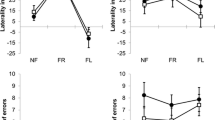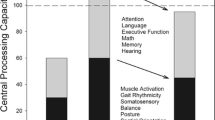Using the computerized GAITRite system, we investigated spatial and temporal parameters of walking in 15-year-old girls, elder (16- to 20-year-old) girls, and 21- to 43-year-old women. These parameters, measured under normal conditions and upon performance of an additional cognitive task (loud pronouncing of names of animals known to the participant), were compared. In all age groups, spatial parameters of walking measured in the presence of cognitive loading underwent no significant alterations, while practically all time parameters demonstrated statistically significant modifications. Durations of the phases of walking increased, while the rate of stepping and velocity of walking decreased. It is concluded that, under conditions of moderate cognitive loading, the parameters of activity of the neuronal locomotor generator (in our tests, generator of walking) undergo a relatively simple modifications, namely “expansion” (elongation) of the time scale with minimum changes in the amplitude parameters. Within the examined general age interval, these modifications showed nearly no dependence on the age of the tested women (or such dependence was minimum).
Similar content being viewed by others
References
M. Woollacott and A. Shumway-Cook, “Attention and the control of posture and gait: a review of an emerging area of research,” Gait Posture, 16, No. 1, 1-14 (2002).
G. S. Moskovko, “Study of the walking function using the GAITRite sustem: Description and normative data,” Biomed. Biosoc. Anthropol., No. 8, 18-22 (2007).
B. N. Ryzhov, “Systemic periodization of the development,” Sist. Psikhol. Sotsiol., No. 5 (I), 5-25 (2012).
M. V. Yoltukhovskii and O. V. Bogomaz, “Effects of additional motor and cognitive tasks on walking in humans,” Neironauki Teor. Klin. Asp., No. 1/2, 10-14 (2011).
O. Beauchet, V. Dubost, F. R. Herrmann, and R. W. Kressig, “Stride-to-stride variability while backward counting among healthy young adults,” J. NeuroEng. Rehab., 2, 1-8 (2005).
V. Dubost, R. W. Kressig, R. Gonthier, et al., “Relationships between dual-task related changes in stride velocity and stride time variability in healthy older adults,” Human Mov. Sci., 25, No. 3, 372-382 (2006).
G. Yogev, J. M. Hausdorff, and N. Giladi, “The role of executive function and attention in gait,” Mov. Disord., 23, No. 3, 329-472 (2008).
G. Yogev, N. Giladi, C. Peretz, et al., “Dual tasking, gait rhythmicity, and Parkinson’s disease: which aspects of gait are attention demanding?” Eur. J. Neurosci., 22, No. 5, 1248-1256 (2005).
J. M. Hausdorff, A. Schweiger, T. Hermann, et al., “Dual-task decrements in gait: Contributing factors among healthy older adults,” J. Gerontol. Ser. A. Biol. Sci. Med. Sci., 63, No. 12, 1335-1343 (2008).
Y. Lajoie, N. Teasdale, C. Bard, and M. Fleury, “Upright standing and gait: are there changes in attentional requirements related to normal aging,” Exp. Aging Res., 22, No. 2, 185-198 (1996).
M. I. Posner, B. E. Sheese, Y. Odludas, and Y. Tang, “Analyzing and shaping human attentional networks,” Neural Netw., 19, No. 9, 1422-1429 (2006).
M. C. Dault, L. Yardley, and J. S. Frank, “Does articulation contribute to modifications of postural control during dual-task paradigms?” Cogn. Res. Cogn. Brain Res., 16, No. 3, 434-440 (2003).
Author information
Authors and Affiliations
Corresponding author
Rights and permissions
About this article
Cite this article
Moroz, V.M., Yoltukhovskii, M.V., Tyshchenko, I.V. et al. Effect of Additional Cognitive Loading on Spatiotemporal Parameters of Walking in Women of Different Age Groups. Neurophysiology 48, 150–154 (2016). https://doi.org/10.1007/s11062-016-9581-y
Received:
Published:
Issue Date:
DOI: https://doi.org/10.1007/s11062-016-9581-y




